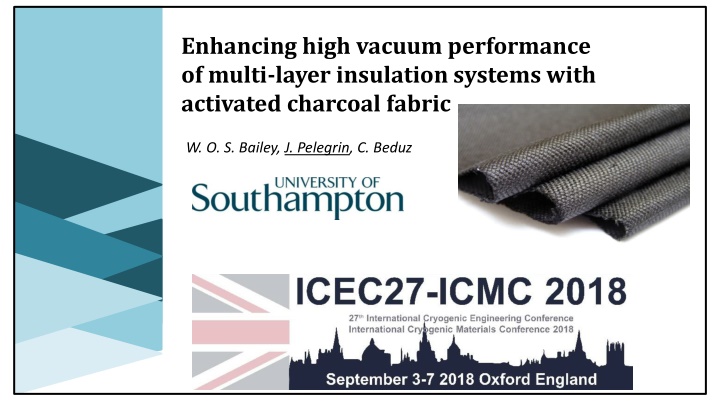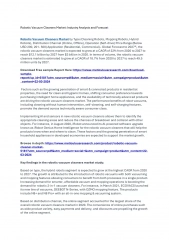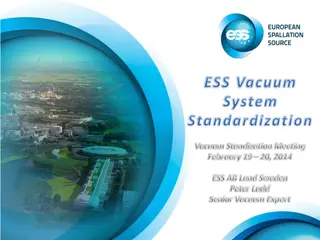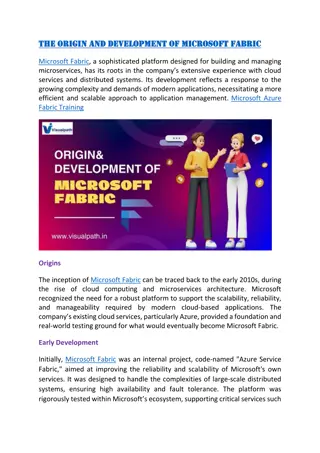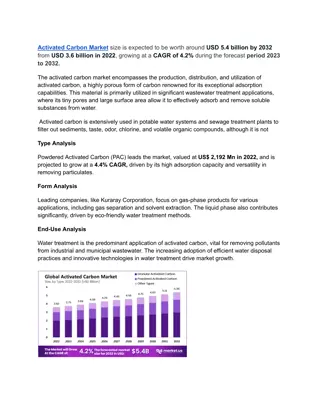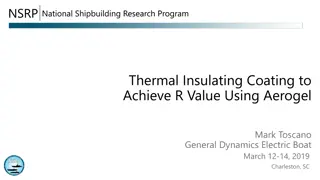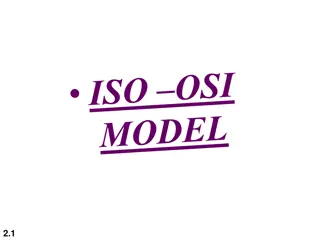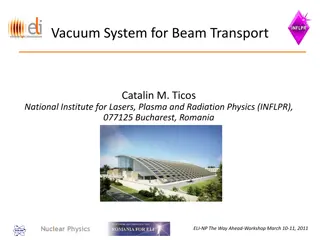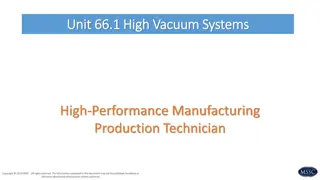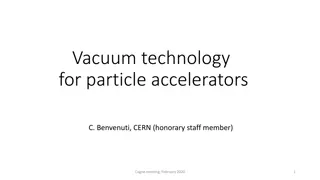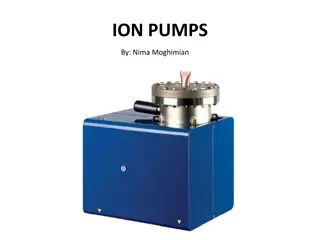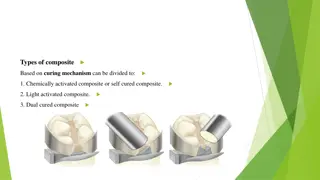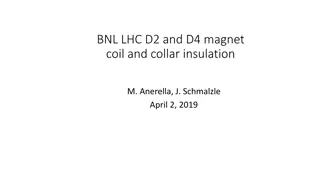Enhancing Vacuum Performance with Activated Charcoal Fabric in Multi-Layer Insulation Systems
Multi-layer insulation (MLI) systems play a crucial role in cryogenic applications, affecting vacuum quality and efficiency. This study explores the use of activated charcoal fabric (ACF) as a potential replacement for traditional spacer materials in MLI, enhancing cryopumping performance. By incorporating activated charcoal into the MLI configurations, improved cryosorption of gases like helium and hydrogen is achieved. Experimental setups, wrapping methodologies, and test results are detailed, highlighting the benefits of activated charcoal cloth in increasing cryogenic system effectiveness and efficiency.
Download Presentation

Please find below an Image/Link to download the presentation.
The content on the website is provided AS IS for your information and personal use only. It may not be sold, licensed, or shared on other websites without obtaining consent from the author.If you encounter any issues during the download, it is possible that the publisher has removed the file from their server.
You are allowed to download the files provided on this website for personal or commercial use, subject to the condition that they are used lawfully. All files are the property of their respective owners.
The content on the website is provided AS IS for your information and personal use only. It may not be sold, licensed, or shared on other websites without obtaining consent from the author.
E N D
Presentation Transcript
Enhancing high vacuum performance of multi-layer insulation systems with activated charcoal fabric W. O. S. Bailey, J. Pelegrin, C. Beduz
Motivation Multi-layer insulation (MLI) is an important component of any cryogenic system. The configuration of MLI can influence the quality and speed to achieve a good vacuum. Some materials, like glass fibre paper, normally used as a spacer are difficult to handle and wrap. New fabrics containing woven activated charcoal fibres (ACF) could potentially replace the glass fibre paper while enhancing cryopumping performance. Adding activated charcoal into the MLI would significantly increase the distribution of the getter throughout the system making it work more effectively and efficiently. Several new combinations of MLI were prepared and liquid nitrogen boil off rates were measured using a calorimeter.
Summary Activated charcoalcloth Experimental setup Wrapping methodology Test methodology Results Summary of results Conclusions Further work
Activated charcoal cloth Activated charcoal is considered a more effective getter material than zeolite for cryosorption of gases like helium and hydrogen. The activated charcoal cloth (ACC) is composed by 100 % activated charcoal fibres. The cloth has an extremely large surface area of 1000 2000 m2/g, compared to activated charcoal in granular form of 889 m2/g). It has a nominal thickness of 500 microns and nominal density of 240 g/m3, (compacted activated charcoal has a density of 460 g/m3). The cloth is easy to handle and can be baked at high temperatures. Layers can be easily removed and reused. The edges of the woven cloth tend to fray when cut. This is not expected to be a problem for the knitted cloth. Knitted cloth Woven cloth
Experimental setup The dimensions of each test vessel (3 off): Diameter: 108 mm Height: 300 mm The middle vessel (measurement) was wrapped with the new MLI configurations Only 5 m2of the ACC was available for testing The top and bottom vessels (guards) were wrapped with Nylon-Mylar blankets
Wrapping methodology The reflecting and insulating layers are wrapped one layer at a time. 10 layers of reflecting material and 9 layers of insulation are wrapped for each test. Thermocouples are placed on layers 2, 3, 5, 7, 9 and 10 with the reference placed on the measurement vessel at 77 K. Insulating layers are made longer to avoid contact between reflecting layers. Insulating Material Thickness Thermal conductivity at 77 K [W/m K] [ m] Aluminium foil (Al) 15 300 Mylar 12 0.15 Glass fibre paper (GFP) 100 0.008 Activated charcoal cloth (ACC) 500 0.25 - 2 Reflecting
Test methodology Test procedure: Wrap the middle vessel. Insert calorimeter into outer vacuum jacket. Pump vacuum space (typically for 1 week). Cool down of guards and measurement vessels. Isolate vacuum pump. Measure liquid nitrogen boil off as a function of time when system settles. Record the vacuum pressure and temperature profile over a period of 1-3 days.
Test methodology Vacuum gauge Test procedure: Instrumentation port Isolation valve Wrap the middle vessel. Insert calorimeter into outer vacuum jacket. Pump vacuum space (typically for 1 week). Cool down of guards and measurement vessels. Isolate vacuum pump. Measure liquid nitrogen boil off as a function of time when system settles. Record the vacuum pressure and temperature profile over a period of 1-3 days. Flow meter Vacuum pump
Results Al + ACC: The first test used Al foil as the reflecting material and ACC as the spacer material. The measured boil off rate was much higher than expected. Very good vacuum pressure achieved thanks to the ACC. Since the ACC can have a relatively high thermal conductivity, the Al (reflecting material) was substituted with Mylar to reduce the thermal conduction between sequential layers. *J. E. Fesmire Phys Procedia 2015;67:1089-97
Results Mylar + ACC: The second test replaced the Al foil with Mylar as the reflecting material and retained the ACC as the spacer material. The boil off rate did not reduced significantly. The vacuum pressure was higher due to a leak in the system, but still between the optimum limit for MLI to be effective. The vacuum pressure was expected to be similar without the leak (or slightly higher due to higher outgassing). The thermal profile could be checked to explain the poor performance of the MLI. *J. E. Fesmire Phys Procedia 2015;67:1089-97
Results Mylar + ACC: The second test replaced the Al foil with Mylar as the reflecting material and retained the ACC as the spacer material. Comparing the temperature distribution at each layer with the analytical solution for 10 layers obtained from: ? ??= [774+ ? + 13004+ 774]1/4 It appears that the heat transfer by conduction is significant across the MLI. It might be due to some contact points in the ACC due the extra length of the spacing layers.
Results Mylar + ACC + GFP: Glass fibre paper (GFP) was added as an additional spacer material after the ACC. Very low boil off rates and low vacuum pressures were achieved. The temperature distribution fits well the analytical model. *J. E. Fesmire Phys Procedia 2015;67:1089-97
Results Al + ACC + GFP: Al foil replaced the Mylar to check if lower vacuum pressure could be achieved Similar values to those measured when using Mylar+ACC+GFP were obtained. The vacuum pressure was 50 % higher, however this particular test was pumped for half the time (3 days) and this is likely to have had an affect on the results. *J. E. Fesmire Phys Procedia 2015;67:1089-97
Summary of results Material Thickness Heat flux (q) Apparent thermal conductvity (ke) Vacuum pressure [m x 10-3] [W/m2] [W/m K] [millitorr] Al + ACC 5.145 7.34 3.04 x 10-4 0.0017 Mylar + ACC 3.850 6.95 2.87 x 10-4 0.1667 Al + ACC + GFP 8.765 0.45 1.77 x 10-5 0.0038 Mylar + ACC + GFP 9.250 0.36 1.48 x 10-5 0.0026 Mylar + carbon loaded paper* 3.240 1.76 2.63 x 10-5 0.0400 Al + GFP* 2.850 2.13 2.81 x 10-5 0.2000 Mylar + GFP* 2.670 3.40 4.17 x 10-5 1.0000 *R. G. Scurlock and B. Saull Sixth International Cryogenic Engineering Conference
Conclusions The activated charcoal cloth has potential to replace getters used in solid/powder form. Activated charcoal cloth is easy to integrate into an MLI system and is quick to wrap. It appears the thermal conductivity of the cloth is too high to use solely as a spacer material, hence, a spacer material like the GFP has to be used. When a spacing material was added to the system, heat flux values similar to those of the standard curves were obtained with low vacuum pressures, equivalent to when using solid getters. Future work: In line with our initial motivation to remove the GFP spacer (difficult to handle and wrap) we intend to investigate some alternative MLI systems: - ACC + Nylon net - ACC + Crinkled/dimpled Al sheet Experimental validation of the optimised number of ACC layers required to enhanced vacuum performance obtained when using getters.
Conclusions Thank you for your attention.
